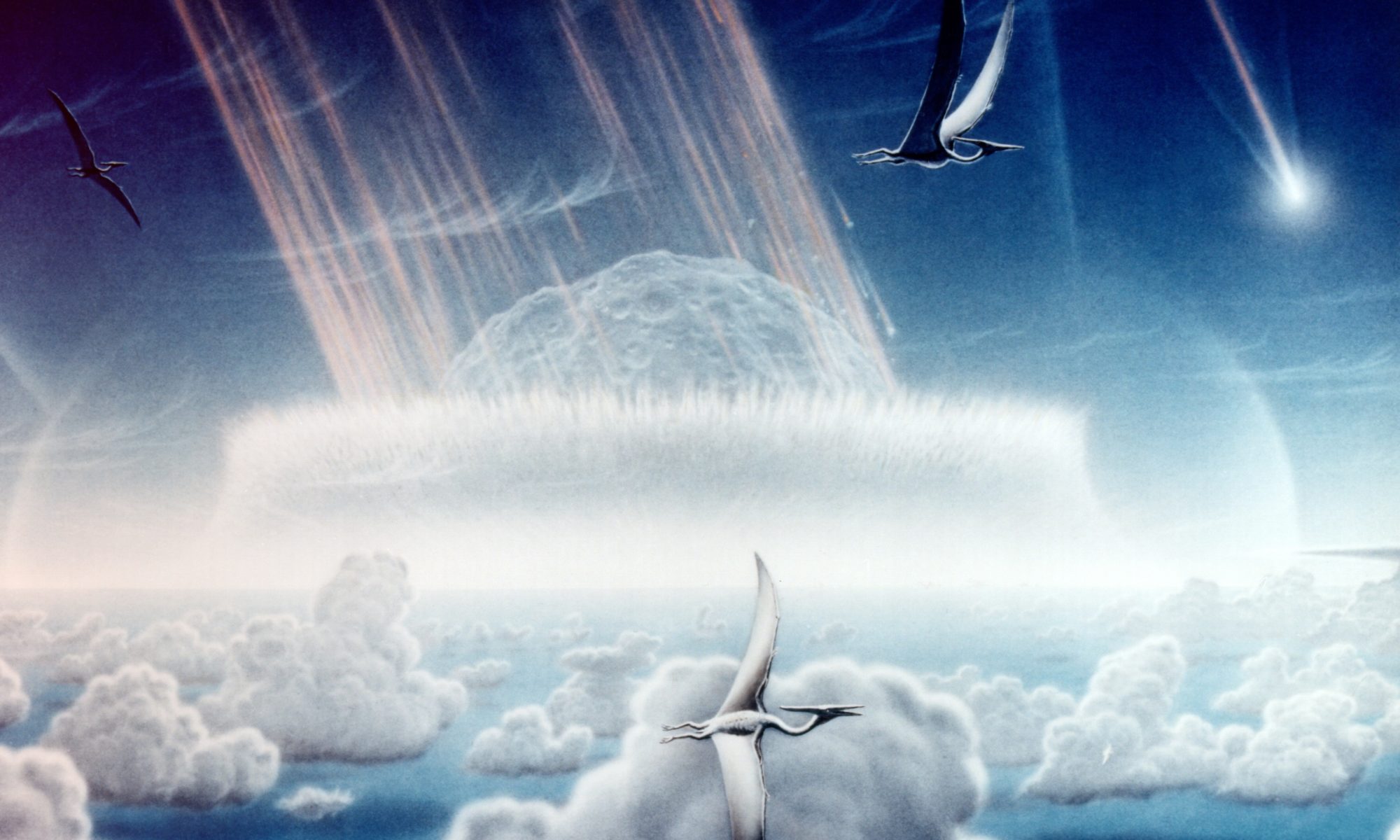Featuring image: 66 million years ago, a giant meteorite impact ended the age of the dinosaurs. Artist impression of the impact. Painting by Donald E. Davis, Public Domain (C0)
Paper: The Nadir Crater offshore West Africa: A candidate Cretaceous-Paleogene impact structure
Authors: U. Nicholson, V. J. Bray, S. P. S. Gulick, B. Aduomahor
The appearance of a flaming, 10 km wide meteorite over the Gulf of Mexico must have been striking, literally. But could the meteorite, which killed the dinosaurs, have had a small sibling or even a whole family of smaller space rocks hurtling towards Earth?
The massive meteorite impact at Chicxulub in the Gulf of Mexico ended the era of the dinosaurs 66 million years ago. Now, only a few thousand km apart from it, researchers might have found another, smaller crater of a similar age. And it might show that the Chicxulub meteorite was not alone but part of a cluster of meteorites, bombarding the Earth at the end of the Cretaceous period.
Finding a meteorite crater is not as easy as you might think. Due to the tectonic activities on Earth and the erosion caused by wind and water, older craters remain hidden to our eyes. However, a technique known as seismology can help to uncover geological structures below us, by sending vibrations into the ground to reveal the structures underground.
Using this technique, Nicholson and co-workers found a structure underneath the Guinea Plateau that resembled a 8.5 km wide, old meteorite crater, now called Nadir Crater. If formed by a meteorite, then the impacting space rock had a diameter of approximately 400 m and would have caused an explosion equivalent to 5000 megatons of TNT. That is enough to create a 5 km wide fireball and a tsunami which reached the west coast of Africa and the east coast of South America. The age of the crater is determined by the age of the sediment layer it was found in. The Nadir Crater formed at the same time as the famous Chicxulub crater. And for coincidence (or maybe not), Chicxulub is only 8000 km away from Nadir Crater. But the craters were closer together in the past, only separated by 5500 km, if plate tectonics is taken.

Nicholson and colleagues present three possible scenarios regarding the connection between Nadir and Chicxulub Crater. First, the impact times and locations are a coincidence. However, when looking at the probability of how often the Earth is hit by large meteorites, this scenario is possible, but highly unlikely. In the second scenario, the two meteorites broke up into a small piece, creating Nadir Crater, and into a big piece, creating Chicxulub Crater. The distance between the two craters suggests that the meteorites didn’t fall apart while entering Earth’s atmosphere, but earlier when they approached Earth’s orbit. A similar case was observed in 1994, when a comet broke into 20 smaller pieces while approaching Jupiter. In the last scenario, the meteorites fell apart long, long ago and travelled together as a cluster through the galaxy. If true, all these meteorites eventually hit Earth not at the same time, but over a few hundreds of thousand of years. The Guinea Plateau meteorite could be the missing puzzle piece, connecting the Chicxulub impact with other impacts at different places on Earth, which are of a similar, but not the same age as Chicxulub.
The Nadir Crater could be an important key to understand the dynamics of meteorite impacts as well as the rate at which a big rock is hitting Earth. Moreover, these remnants of old catastrophes, wiping out thousands of species, should remind us how valuable life is and that even we humans are small compared to the forces of nature.
License:
‘Chicxulub’s small sibling’ by Max Winkler is licensed under a Creative Commons Attribution-ShareAlik

